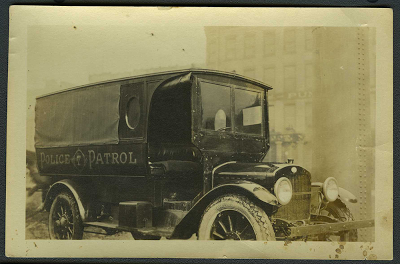With notorious criminal photos like these in the mix, it’s not surprising that the album was thought to have belonged to a federal agent. But, after a call to the album’s previous owner, Museum staff discovered that the FBI connection was a red herring. The prior owner clarified some of the facts, namely that she found the album inside of an abandoned storage unit in Houston, Texas. She had no idea about the origins of the album, but guessed it might have come from a local officer. So, that left Museum staff with lots to investigate. The overt clues within the album—stamps from the Houston Chronicle, a reference to Chocolate Bayou (a bayou near Houston), and the seal of the Houston Police Department—all pointed to Houston. The significance of another less obvious clue, a word that looked like "Busted" or “Buster” handwritten in pencil on the back of many of the photos, was initially hazy, but it would eventually lead back to Houston, too.
Click the photos to view on Flickr and read what we know about them.
Upon further examination, yet another Houston link was found. One of the little-known episodes depicted in the photographs happened to be one that’s very familiar to the Museum: the January 1932 confrontation between Houston police and Harry and Jennings Young. The Young Brothers were on the run after a shootout in Missouri that resulted in the death of six law enforcement officers. Acting on a tip, the Houston police, armed with shotguns and tear gas, surrounded the brothers’ rented cottage in downtown Houston. When officers had the brothers cornered in the cottage bathroom, they heard one brother shout, “we’re dead—come and get us,” followed by several gunshots. Rather than surrender, the brothers had shot each other.
Now with five photographs correctly attributed to the Young Brothers case, the Museum had inadvertently attained more important pieces of law enforcement history than anyone had first thought. With this newfound information, staff began to wonder—what other stories might the album have to tell? A closer look revealed one officer who was in many of the photographs. Could he be the album’s original owner? Might his name be Buster?
The Museum turned to Officer James Chapman of the Houston (TX) Police Department for help identifying the mysterious officer. In no time at all, we had our answer—the officer was Clairville V. Kern, also known as Buster. Buster Kern served as a patrolman, mounted officer, motorcycle officer, captain, and chief of detectives with the Houston Police Department, before he was elected Sheriff of Harris County. He was the county’s longest-serving sheriff, holding the office from 1949 to 1972.
A lawman in Texas for over 40 years, C.V. “Buster” Kern saw it all. He solved murders, faced off against gangsters, even got in a fistfight with a prosecutor. This water-damaged album provides a brief look into the world in which he lived. The Museum is proud to have it in its collection. However, its preservation is bittersweet—in talking to the album’s previous owner, we learned that the storage unit had held dozens of similar albums that she “trashed” because of the gory photographs they contained. This one album “slipped out of a box and went unseen for a couple of weeks,” at which point she opened it and saw the picture of Clyde Barrow. Ironically, an important story of law enforcement was saved, all thanks to a photo of a petty bank robber and murderer.
By looking for cases associated with Kern, one series of previously unidentified photographs of dive operations has been linked to the gangland-style slaying of Houston restaurant owner Vincent Vallone in 1949. But there is more research to be done and cases to unravel, so take a look at the photos above and see if there is anything you can add to the story.
The Museum turned to Officer James Chapman of the Houston (TX) Police Department for help identifying the mysterious officer. In no time at all, we had our answer—the officer was Clairville V. Kern, also known as Buster. Buster Kern served as a patrolman, mounted officer, motorcycle officer, captain, and chief of detectives with the Houston Police Department, before he was elected Sheriff of Harris County. He was the county’s longest-serving sheriff, holding the office from 1949 to 1972.
A lawman in Texas for over 40 years, C.V. “Buster” Kern saw it all. He solved murders, faced off against gangsters, even got in a fistfight with a prosecutor. This water-damaged album provides a brief look into the world in which he lived. The Museum is proud to have it in its collection. However, its preservation is bittersweet—in talking to the album’s previous owner, we learned that the storage unit had held dozens of similar albums that she “trashed” because of the gory photographs they contained. This one album “slipped out of a box and went unseen for a couple of weeks,” at which point she opened it and saw the picture of Clyde Barrow. Ironically, an important story of law enforcement was saved, all thanks to a photo of a petty bank robber and murderer.




































